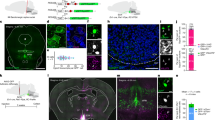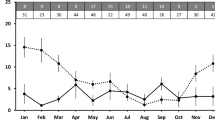Abstract
Animals inhabiting areas where there are drastic changes in the environment often reproduce only during limited time periods to ensure that young are raised in optimal environmental conditions1. The lack of a well defined breeding season in many domesticated animals2,3, presumably because the selective pressures for seasonal breeding have been minimized, suggests that the neuroendocrine events controlling seasonal cyclicity have been bred out of these animals. Little is known about the underlying neuroendocrine changes which may occur during the evolution of a species from a seasonal to a nonseasonal breeder. Whereas the changing photoperiod is the primary environmental cue which initiates and/or terminates the reproductive season in many animals4, this is not so in the albino rat Rattus norvegicus, a model nonseasonal breeder5–7. Nevertheless, daylength can influence various reproductive parameters in laboratory rats 8–17, suggesting that some of the neuroendocrine components that controlled seasonal breeding previously are still extant in this species. To test this hypothesis, we investigated the effect of daylength on the responsiveness of the neuroendocrine–gonadal axis to the negative-feedback effects of testosterone. This paradigm was chosen because of the important role played by photic-induced changes in steroid feedback sensitivity in the control of seasonal reproduction18–21. We report here that although daylength has very little effect on neuroendocrine–gonadal function in the intact male laboratory rat, it seems that some component(s) of a photoperiodic system involving the pineal gland has been preserved.
This is a preview of subscription content, access via your institution
Access options
Subscribe to this journal
Receive 51 print issues and online access
$199.00 per year
only $3.90 per issue
Buy this article
- Purchase on SpringerLink
- Instant access to full article PDF
Prices may be subject to local taxes which are calculated during checkout
Similar content being viewed by others
References
Assenmacher, I. & Farner, D. S. (eds) Environmental Endocrinology 1–122 (Springer, Berlin, 1978).
Lodge, J. R. & Salisbury, G. W. in The Testis Vol 3 (eds Johnson, A. D., Gomes, W. R. & Vandemark, N. L.) 139–167 (Academic, New York, 1970).
Schwartz, N. B. in The Hypothalamus (eds Martini, L., Motta, M. & Fraschmi, F.) 515–528 (Academic, New York, 1970).
Turek, F. W. & Campbell, C. S. Biol. Reprod. 20, 32–50 (1979).
Kinson, G. A. & Robinson, S. J. Endocr 47, 391–392 (1970).
Reiter, R. J. et al. Endocrinology 88, 895–900 (1971).
Kinson, G. A. & Liu, C. Life Set. 14, 2179–2188 (1974).
Hoffmann, J. C. Biol. Reprod. 2, 255–261 (1970).
Hoffmann, J. C. & Culling, A.-M. Neuroendocrinology 23, 285–296 (1977).
Wallen, E. P. & Yochim, J. M. Biol. Reprod. 11, 117–124 (1974).
McCormack, C. E. Fedn Proc. 31, 811 (1972).
Sridaran, R. & McCormack, C. E. Biol. Reprod. 20, 705–712 (1979).
Yochim, J. M. & Mitchell, J. A. Endocrinology 87, 465–471 (1970).
Mitchell, J. A. & Yochim, J. M. Endocrinology 87, 472–480 (1970).
Sorrentino, S. Jr., & Benson, B. Gen. comp. Endocr. 15, 242–246 (1970).
Shapiro, M. I., Collu, R., Masse, D., Ducharme, J. R. & Roux, J. F. Life Sci. 19, 1341–1346 (1976).
Piacsek, B. E. & Meites, J. Neuroendocrinology 2, 129–137 (1967).
Pelletier, J. & Ortavant, R. Acta endocr. 78, 442–450 (1975).
Tamarkin, L., Hutchison, J. S. & Goldman, B. D. Endocrinology 99, 1528–1533 (1976).
Legan, S. J., Karsch, F. J. & Foster, D. L. Endocrinology 101, 818–824 (1977).
Ellis, G. B. & Turek, F. W. Endocrinology 104, 625–630 (1979).
Hoffman, R. A. & Reiter, R. J. Anat. Res. 153, 19–22 (1965).
Turek, F. W. Endocrinology 101, 1210–1215 (1977).
Berndtson, W. E., Desjardins, C. & Ewing, L. L. J. Endocr. 62, 125–135 (1974).
Campbell, C. S. & Schwartz, N. B. J. Tox. envir. Hlth. 3, 61–95 (1977).
Bex, F. J. & Bartke, A. Endocrinology 100, 1223–1226 (1977).
Bartke, A. et al. Endocrinology 106, 167–172 (1980).
Turek, F. W. Endocrinology 104, 636–640 (1979).
Ronnekleiv, O. K. & McCann, S. M. Neuroendocrinology 19, 97–114 (1975).
Alonso, R., Prieto, L. & Mas, M. Endocrinology 102, 1534–1538 (1978).
Jacobson, C. D. & Mann, D. R. Biol. Reprod. 18, 712–718 (1978).
Brown-Grant, K. & Ostberg, A. J. C. J. Endocr. 62, 45–50 (1974).
Blake, C. A. J. Endocr. 69, 67–75 (1976).
Takeo, Y., Shirama, K., Shimizu, K. & Maekawa, K. Annotnes zool. jap. 49, 83–89 (1976).
Davis, G. J. & Meyer, R. K. Gen. comp. Endocr. 20, 61–68 (1973).
Gibson, W. R., Follett, B. K. & Gledhill, B. J. Endocr. 64, 87–101 (1975).
Pelletier, J. & Ortavant, R. Acta endocr. 78, 435–441 (1975).
Ellis, G. B. Biol. Reprod. 20, Suppl. 1, 30A (1979).
Author information
Authors and Affiliations
Rights and permissions
About this article
Cite this article
Wallen, E., Turek, F. Photoperiodicity in the male albino laboratory rat. Nature 289, 402–404 (1981). https://doi.org/10.1038/289402a0
Received:
Accepted:
Issue date:
DOI: https://doi.org/10.1038/289402a0
This article is cited by
-
Influence of melatonin and photoperiod on animal and human reproduction
Journal of Endocrinological Investigation (1996)
-
Pineal melatonin rhythms and the timing of puberty in mammals
Experientia (1989)
-
The effect of daily evening isoproterenol administration on reproductive organ growth in male rats treated neonatally with testosterone propionate
Experientia (1983)



